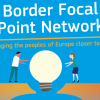The border between Spain and Portugal, also known as “The Stripe” (La Raya) stretches for 1,214 kilometers, from the Atlantic coast to the eastern edge of the Iberian Peninsula. Recent focus on mutual development has made both countries to take steps towards promoting cooperation at a very young age, through the creation of the “Border Schools” project.
WHAT
This project, named the Border Bilingual and Intercultural Schools Project (EBIF - Escuelas Bilingües e Interculturales de Frontera), was initiated as a mutual effort between Spain and Portugal in the context of increasing cross-border cooperation, including in education. The initiation of the project was facilitated by a joint declaration during the XXX Summit between Spain and Portugal in 2018, which explicitly expressed their commitment to supporting educational experiences in border areas. Specifically, within the realm of education, Article 16 of this declaration highlighted the commitment of both countries to endorse educational experiences in transborder areas. This commitment underscored the need for transnational collaboration, particularly in border regions, aiming to foster bilingual education, exchange learning practices, promote mutual understanding, strengthen community bonds, and appreciate cultural diversity.
The aim/objective of the EBIF project is to promote cooperation between Spain and Portugal in the educational, social, and economic development of their border territories. The project seeks to provide quality education to children and youth living in these border regions, encompassing knowledge, skills, and values associated with bilingualism and interculturality.
Specifically, the objectives of the EBIF include:
- Empowering and training teachers in plurilingual, intercultural, and digital competencies through continuous education.
- Encouraging bilingual and intercultural pedagogical practices that can be shared within the school community (teachers, students, and their families) and with local institutions.
- Producing multilingual educational resources, with a focus on Portuguese-Spanish bilingualism, through ongoing monitoring of school practices.
- Establishing collaboration networks between educational institutions and teachers through digital platforms, facilitating interaction among various project stakeholders and the sharing of educational and cultural resources.
- Promoting the coordination of schools with higher education institutions and other local actors, particularly municipalities, in border regions.
- Positioning border schools as hubs that promote the benefits of bilingual education and foster an understanding of the richness of linguistic and intercultural diversity.
The methodology employed for this project is rooted in action research, strengthening a continuous and interactive process shared by all participants. This approach supports collaborative efforts in organizing school activities, managing curricula, and producing high-quality multilingual educational resources.
WHO
This project, involves the Organización de Estados Iberoamericanos (OEI), the Ministry of Education of Portugal, the Education Councils of Castilla y León, Extremadura, and Andalusia in Spain, the Complutense University of Madrid, and the University of Aveiro (both universities equally providing scientific advice), is a four-year project, 2020-2024, organized into academic years, as it involves the development of learning projects in schools.

WHERE
The network of border schools is located in the following territories: regions of Portugal - North, Center, Alentejo and Algarve, and in the Autonomous Communities of Andalusia, Castilla y León, Extremadura and Galicia.
HOW
This project was initiated when Spain and Portugal have signed a Joint Declaration at the XXX Hispano-Lusa Summit in 2018 which addresses cooperation in the field of education, specifically via Article 16 of this Declaration which reflects the commitment of the involved countries to support educational experiences in border areas.
RESULTS
Since its inception, the network of Border Schools between Spain and Portugal has been growing and is currently made up of 56 schools on both sides of the border, in which more than 100 teachers and approximately 1,500 students participate.
The participating schools are spread along the border between Portugal and Spain, so that educational practices integrate the values of multilingualism and linguistic and cultural diversity in collaborative work. The project encourages the active participation of teachers from the centers involved in the development of joint innovative educational projects.
The project itself has been designed to be replicable (at least on a smaller scale) so that there are possibilities of maintaining it independently of the official support it receives. Given the objectives of EBIF, both direct beneficiaries (students who acquired plurilingual and intercultural competencies and teachers who underwent training) and indirect beneficiaries (teachers not participating in the project, families, museums, cultural centers, libraries, non-participating schools, language teachers' associations, among others) will be able to continue advocating for interculturality and the cultural and linguistic diversity of the border.
- Log in to post comments

